September 17, 2025

The article titled "7 Types of Differential Reinforcement in ABA Explained" delves into the various types of differential reinforcement techniques employed in Applied Behavior Analysis (ABA) to effectively modify behaviors. It is essential to understand these techniques, as they play a crucial role in shaping positive behavior changes while mitigating undesirable actions across diverse environments, particularly in educational settings.
Among the techniques discussed are Differential Reinforcement of Alternative Behavior (DRA) and Differential Reinforcement of Incompatible Behavior (DRI). Each type is meticulously detailed with relevant examples and robust evidence demonstrating their effectiveness. By exploring these methods, readers can gain insight into how to implement these strategies to foster a more conducive learning atmosphere.
As you reflect on your current behavior modification challenges, consider how these differential reinforcement techniques can be integrated into your practice. The article not only provides a comprehensive overview but also serves as a guide for practitioners seeking to enhance their approach in ABA. Embrace the opportunity to refine your skills and improve outcomes through the application of these proven techniques.
Understanding the various types of differential reinforcement in Applied Behavior Analysis (ABA) is crucial in today's therapeutic landscape. With the growing demand for Board Certified Behavior Analysts (BCBAs), practitioners must enhance their methodologies to improve outcomes. These techniques not only provide a framework for promoting positive behaviors but also constructively address unwanted actions.
As the field evolves, how can practitioners effectively implement these strategies to ensure meaningful behavior change? What methods stand out as the most effective, and how can they be tailored to meet individual needs? Exploring these questions is essential for advancing therapeutic practices.
The demand for Board Certified Analysis Professionals (BCBAs) is projected to rise by an astounding 22% to 23% over the next decade. In this competitive landscape, Hire ABA serves as a specialized recruitment platform, streamlining the job matching process through personalized resume assessments and advanced job fit scoring. This innovative approach ensures that qualified professionals connect with premier job opportunities that align with their skills, preferences, and desired locations.
At Hire ABA, we focus on creating a supportive environment for candidates, significantly enhancing their chances of finding roles that resonate with their expertise and career aspirations. By leveraging cutting-edge technology, including telehealth and remote work options, alongside industry insights, we simplify the hiring journey for both job seekers and employers in the ABA therapy sector.
The surge in job vacancies for specialists in the field is remarkable, skyrocketing from 789 in 2010 to over 57,596 in 2022. This dramatic increase reflects the growing acknowledgment of Applied Behavior Analysis (ABA) as an effective treatment for autism and related disorders. As industry leaders have noted, the demand for BCBAs continues to outpace that of many other professions, positioning this as an attractive and sustainable career choice.
Are you facing challenges in finding the right talent for your organization? Consider how Hire ABA can address these issues and connect you with top-tier candidates. With our expertise and commitment to excellence, we are here to and elevate the standards of ABA therapy.
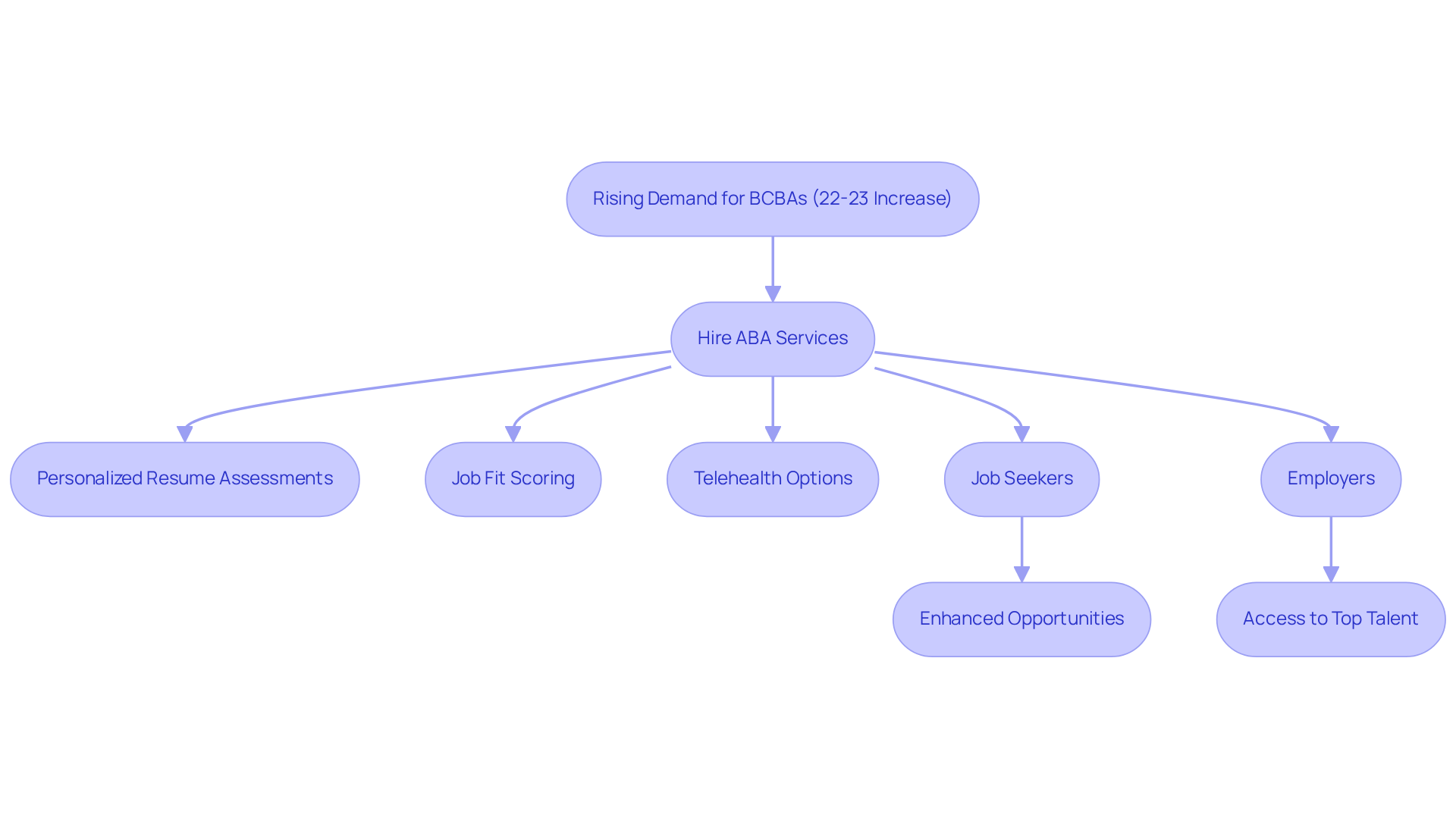
Differential Reinforcement of Alternative Actions (DRA) is considered one of the [types of differential reinforcement ABA](https://hireaba.today), as it serves as a powerful strategy within behavioral interventions by reinforcing an action that acts as a substitute for an unwanted behavior. For instance, when a child shouts to gain attention, a Board Certified Behavior Analyst (BCBA) may reinforce the child for raising their hand instead. This method not only promotes positive behaviors but also effectively reduces the occurrence of the unwanted conduct by providing a functional alternative.
DRA has demonstrated significant advantages in educational environments, where fostering appropriate communication can greatly enhance classroom dynamics. Recent studies indicate that implementing DRA leads to improved student engagement and a reduction in disruptive actions. For example, a teacher who consistently praises students for raising their hands rather than calling out has noted a marked decrease in interruptions during lessons.
Current research underscores the effectiveness of DRA across various contexts, particularly in special education. BCBAs emphasize that tailoring DRA approaches to the unique needs of each student is crucial for achieving success. Understanding the underlying motivations for behaviors is vital for , as it empowers educators to cultivate a supportive environment that encourages positive changes. Furthermore, obtaining informed consent from individuals or guardians is essential prior to implementing DRA strategies, ensuring that ethical considerations are upheld.
The foundational role of types of differential reinforcement ABA in enhancing quality of life and adaptive functioning cannot be overstated. Research indicates that types of differential reinforcement ABA, specifically differential encouragement methods, significantly diminish challenging behaviors such as aggression and tantrums. The adaptability of DRA allows it to be modified for various educational settings, making it a valuable resource for educators aiming to enhance student conduct and learning outcomes. As noted by All Star ABA, "Implementing differential reinforcement strategies means we need to tailor our approach to each person," which emphasizes the importance of customization in achieving effective results.
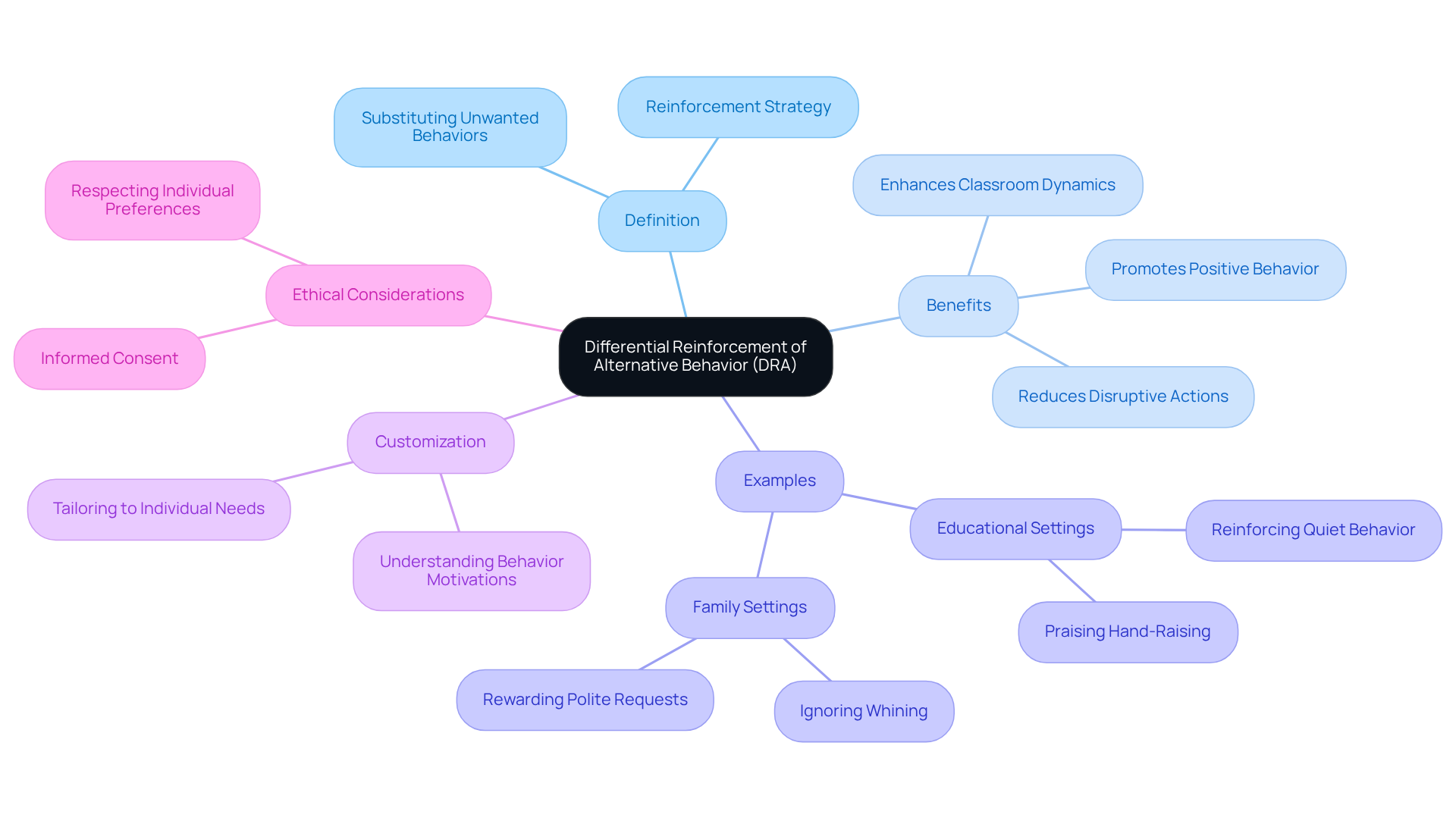
Differential Reinforcement of Incompatible Actions (DRI) stands out as a powerful technique, effectively strengthening actions that cannot occur simultaneously with unwanted behaviors. Consider this: if a child exhibits aggressive behaviors, such as hitting, a Board Certified Behavior Analyst (BCBA) may reinforce the child for keeping their hands in their lap. This method significantly reduces the frequency of challenging actions by promoting an alternative response that is incompatible with aggression.
Recent studies underscore the success of DRI in mitigating physical aggression among children. A compelling case study demonstrated substantial reductions in aggressive behaviors when children received consistent rewards for engaging in incompatible activities, like using words to express frustration instead of resorting to physical outbursts. This approach not only addresses immediate conduct but also fosters , making it particularly advantageous in environments where aggression poses a concern.
Statistics reveal that 32% of children under 6 years of age engage in self-harm, highlighting the prevalence of challenging actions that DRI can effectively address. Behavior analysts emphasize the importance of selecting appropriate reinforcement strategies tailored to individual needs. As one specialist insightfully noted, "When an action is rewarded, its occurrence is more likely to increase," reinforcing the connection between positive incentives and behavioral changes—an essential factor for the effectiveness of DRI.
Current trends in ABA therapy indicate a growing reliance on types of differential reinforcement ABA techniques, demonstrating a shift towards more humane and constructive approaches to behavior modification. Ethical considerations in the application of DRI include ensuring that reinforcement strategies respect individual autonomy while avoiding the promotion of detrimental actions.
In practice, DRI has proven to decrease challenging behaviors in children by establishing clear contingencies that guide them toward more adaptive responses. By reinforcing incompatible actions, practitioners can assist children in developing vital skills for managing their emotions and interactions, ultimately leading to improved outcomes in both therapeutic and everyday settings.

Differential Reinforcement of Other Actions (DRO) is a strategic approach that exemplifies one of the types of differential reinforcement ABA, designed to promote the absence of unwanted behaviors within a specified timeframe. For instance, a Board Certified Behavior Analyst (BCBA) may reward a child for maintaining calmness during a designated period, effectively encouraging the non-occurrence of outbursts rather than merely attempting to replace them. This method proves particularly advantageous for addressing behaviors that are challenging to substitute, as it emphasizes the importance of from engaging in problematic activities.
Recent studies underscore the effectiveness of DRO across various settings, including educational institutions, where it has been successfully utilized to manage disruptive behaviors. By reinforcing periods of calmness, educators can foster a more conducive learning environment. Furthermore, research indicates that types of differential reinforcement ABA, including DRO, can significantly reduce outbursts and other challenging behaviors, rendering it a valuable tool in Applied Behavior Analysis (ABA) therapy. As noted by a BCBA, the types of differential reinforcement ABA, including DRO, effectively decrease the occurrence of unwanted actions by reinforcing any response that is not the target action, making it a versatile option for various behavioral concerns.
The adaptability of types of differential reinforcement ABA, particularly DRO, allows for customization to meet individual needs, promoting positive change without reliance on punitive measures. However, it is crucial to acknowledge that individuals may experience frustration if they fail to complete the DRO interval successfully. As practitioners continue to refine and enhance DRO strategies, the focus remains on nurturing an environment where individuals can thrive by encouraging positive behaviors and minimizing unwanted ones. This approach not only aids in immediate behavior management but also fosters long-term behavioral improvements.
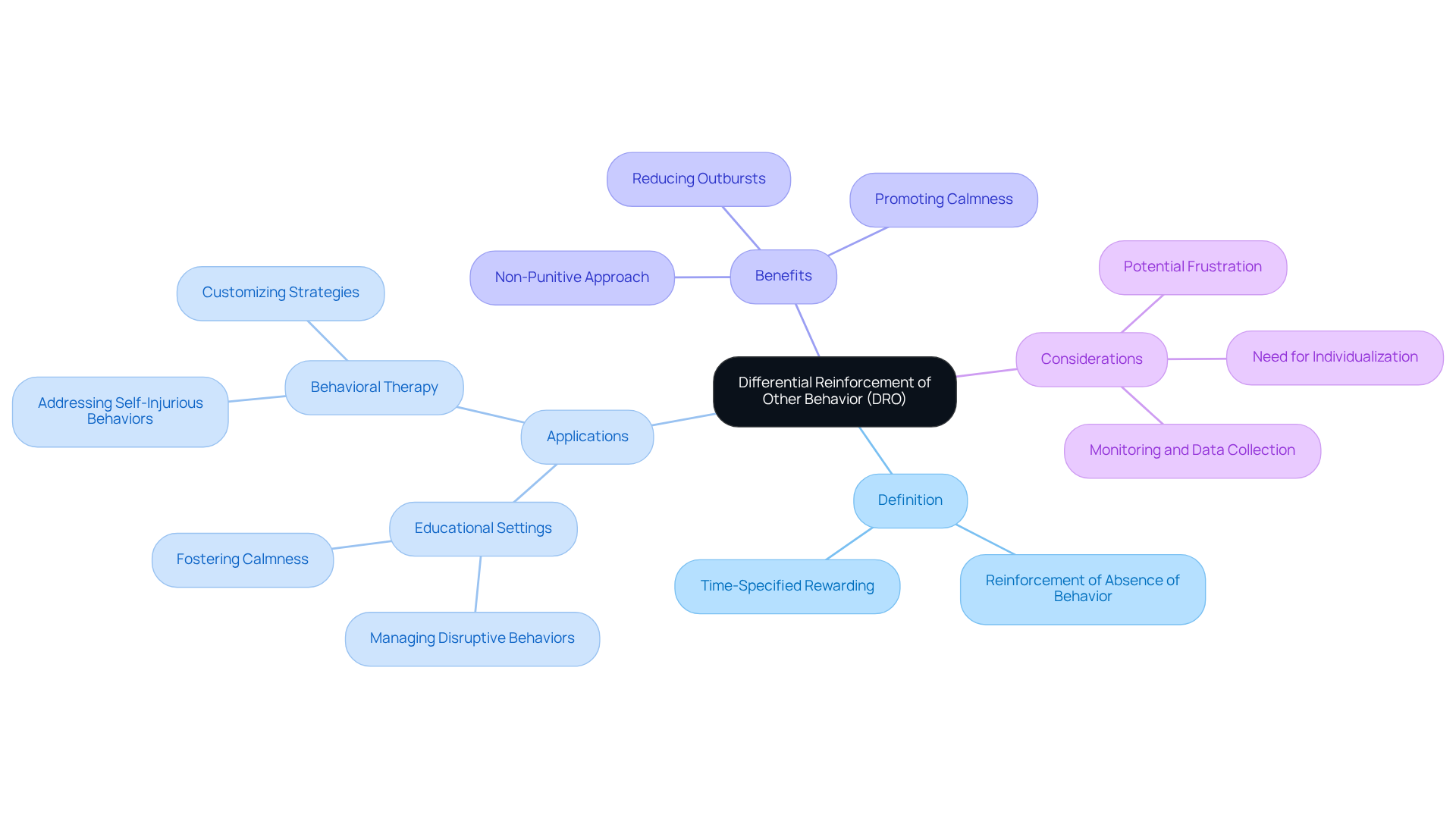
Differential Reinforcement of Lower Rates of Conduct (DRL) is a strategic method designed to reduce the frequency of actions that, although acceptable, occur too often. Consider a classroom scenario: when a student frequently calls out answers, a Board Certified Behavior Analyst (BCBA) may implement a DRL strategy by reinforcing the student for limiting their outbursts to a designated number during a lesson. This approach not only aids in gradually decreasing the frequency of the action but also allows for its continued expression within acceptable limits.
In 2025, the utilization of DRL among BCBAs has gained significant traction, particularly in educational environments that encourage active participation yet require moderation. Success stories abound, with educators reporting notable improvements in classroom dynamics. For instance, one teacher observed that by applying DRL, students began to raise their hands instead of calling out, resulting in a more organized and respectful classroom atmosphere. As seasoned educator Yolanda Williams states, 'Types of differential reinforcement ABA are essential in managing classroom conduct effectively.'
Moreover, the types of differential reinforcement ABA prove effective in managing the frequency of acceptable conduct by reinforcing students for demonstrating restraint. This method cultivates a where students feel encouraged to participate while also learning the importance of timing and appropriateness in their contributions. Research substantiates the effectiveness of DRL, with studies indicating that behaviors can be significantly reduced without reliance on punishment or extinction alone. Furthermore, the importance of data collection for tracking progress cannot be overstated, as it informs ongoing adjustments in support strategies. As research continues to affirm the efficacy of types of differential reinforcement ABA, its application in educational settings remains a crucial tool for BCBAs and educators alike.
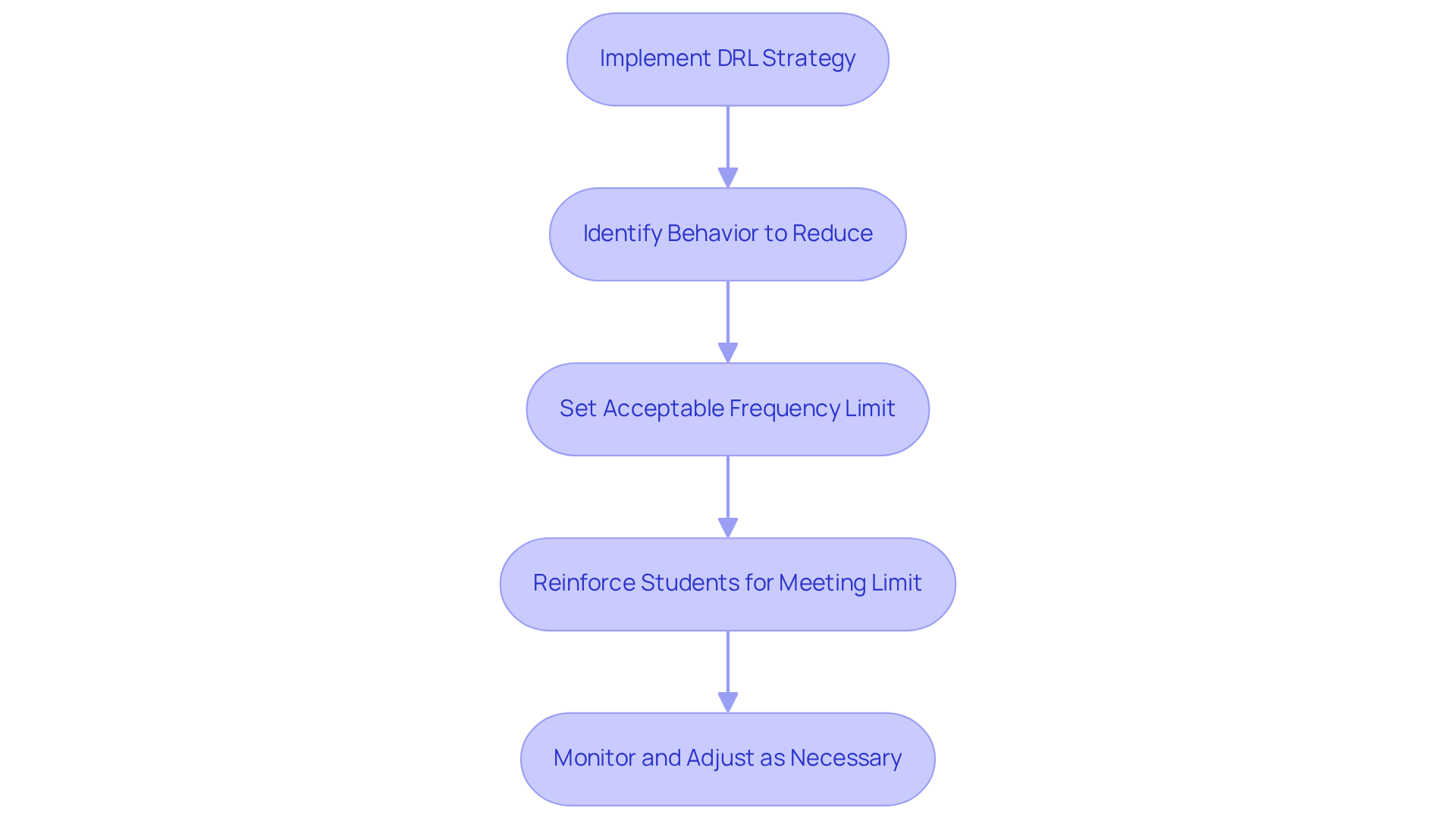
Differential Reinforcement of Higher Rates of Conduct (DRH) is crucial for supporting actions that exceed a designated frequency threshold. For example, a Board Certified Behavior Analyst (BCBA) can encourage a student to engage more actively in class discussions by providing rewards for contributing at least three times during a session. This method not only increases the frequency of desired behaviors but also fosters a more .
Research in 2025 indicates that DRH is especially effective in educational settings where active participation is vital for student growth and engagement. By creating an atmosphere of encouragement, educators can significantly boost classroom participation, leading to improved learning outcomes. Effective applications of DRH in classroom discussions reveal that consistent encouragement of enhanced participation not only motivates students but also nurtures a culture of collaboration and collective learning.
Behavior analysts assert that the strategic use of types of differential reinforcement ABA, including DRH, can facilitate lasting behavioral changes, establishing it as an essential tool in Applied Behavior Analysis therapy. As B.F. Skinner famously stated, 'Give me a child and I'll mold him into anything,' underscoring the transformative potential of supportive methods. It is also critical to recognize that behavior is shaped by its consequences; thus, thoughtfully adjusting incentive parameters can markedly improve behavior change results.
Teachers are encouraged to implement DRH techniques by:
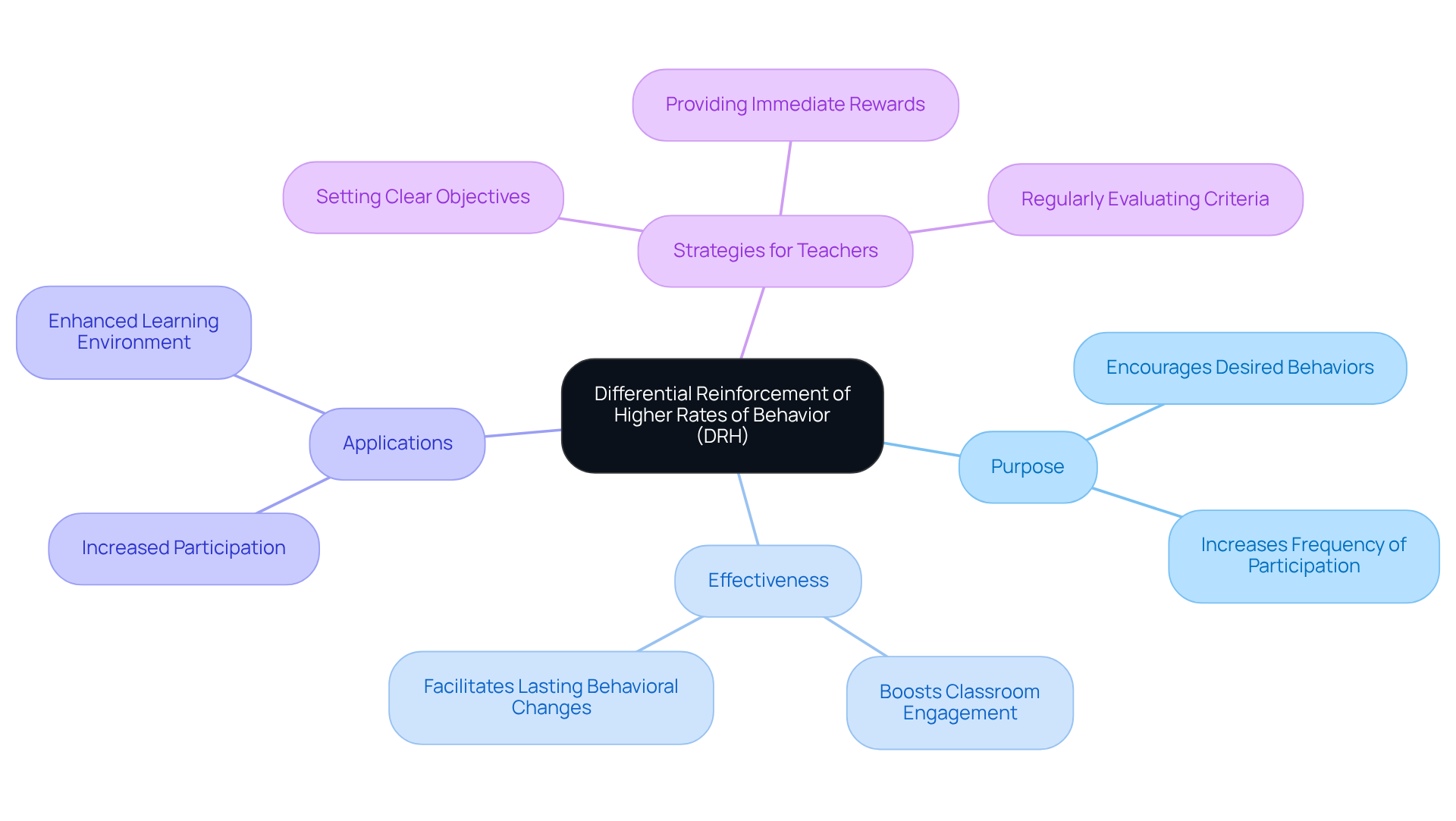
Implementing differential reward strategies is essential in today’s landscape, where the demand for Board Certified Behavior Analysts (BCBAs) continues to rise. Meticulous planning and a deep understanding of each client's unique needs are paramount. BCBAs should begin by accurately defining target actions and selecting suitable reinforcers that resonate with the individual. Consistency plays a critical role; reinforcement must be provided immediately after the desired action to strengthen the connection between action and reward.
Moreover, ongoing data collection is vital for tracking progress and refining interventions as necessary. This process involves safely archiving and analyzing information to ensure the . By customizing approaches to fit each client's unique situation, BCBAs can significantly promote positive changes and enhance therapeutic outcomes.
As one specialist articulated, 'Effective differential support depends on systematically withholding rewards for unwanted actions and offering incentives for preferred and alternative actions.'
Additionally, research indicates that behavioral interventions utilizing types of differential reinforcement aba, including:
have an impressive average effectiveness of 91.9%. This method not only improves the quality of interventions but also aligns with the current best practices in the field. Are you ready to elevate your practice by understanding these strategies? Consider how tailored approaches can transform your therapeutic outcomes.
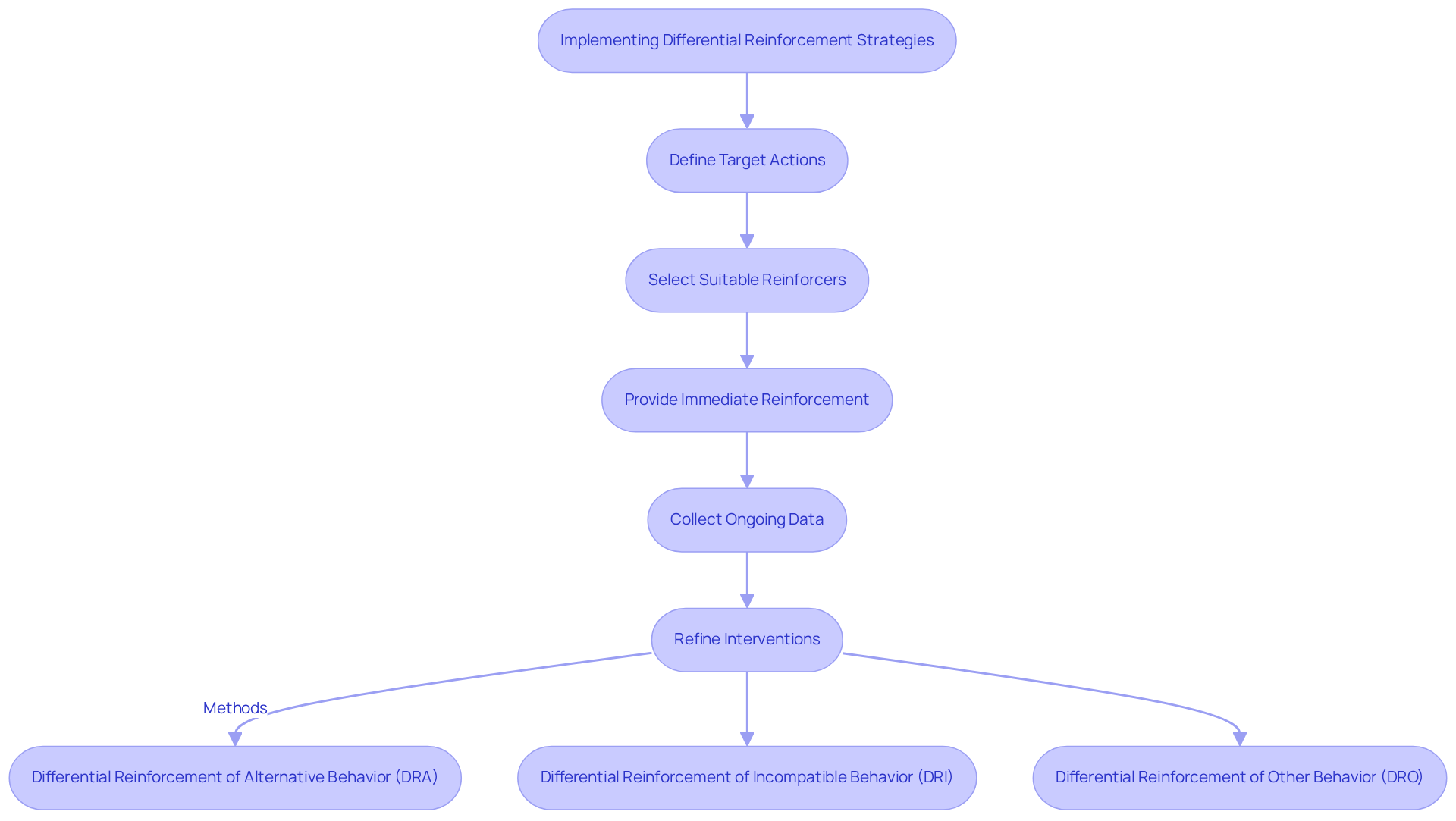
Assessing the effectiveness of differential reward strategies is crucial for Board Certified Behavior Analysts (BCBAs) aiming to improve client outcomes. Monitoring key indicators such as the frequency of target behaviors, the rate of reward delivery, and overall progress towards behavioral objectives is essential. For instance, baseline data indicating an average of 6.67 instances per hour provides a clearer context for measuring effectiveness. To gather relevant information, BCBAs should utilize data collection methods including:
Moreover, it is vital to consider the different types of [differential reinforcement ABA](https://hireaba.today), including:
Each of the types of differential reinforcement ABA has specific applications that can significantly enhance intervention effectiveness. Analyzing this data allows practitioners to determine whether the intervention is successful and to make informed adjustments as needed.
Cultural awareness and personal preferences must also be integrated into the execution of these approaches. This guarantees that interventions remain respectful and effective, particularly in diverse environments. Regular reviews of progress are necessary to ensure that strategies align with the client's evolving needs.
Statements from specialists, including Dr. Mark Berg, underscore the importance of establishing and overseeing data gathering techniques to improve the overall effectiveness of Applied Behavior Analysis (ABA) interventions. By employing these data gathering techniques and success indicators, practitioners can promote positive behavior changes and enhance outcomes for their clients.
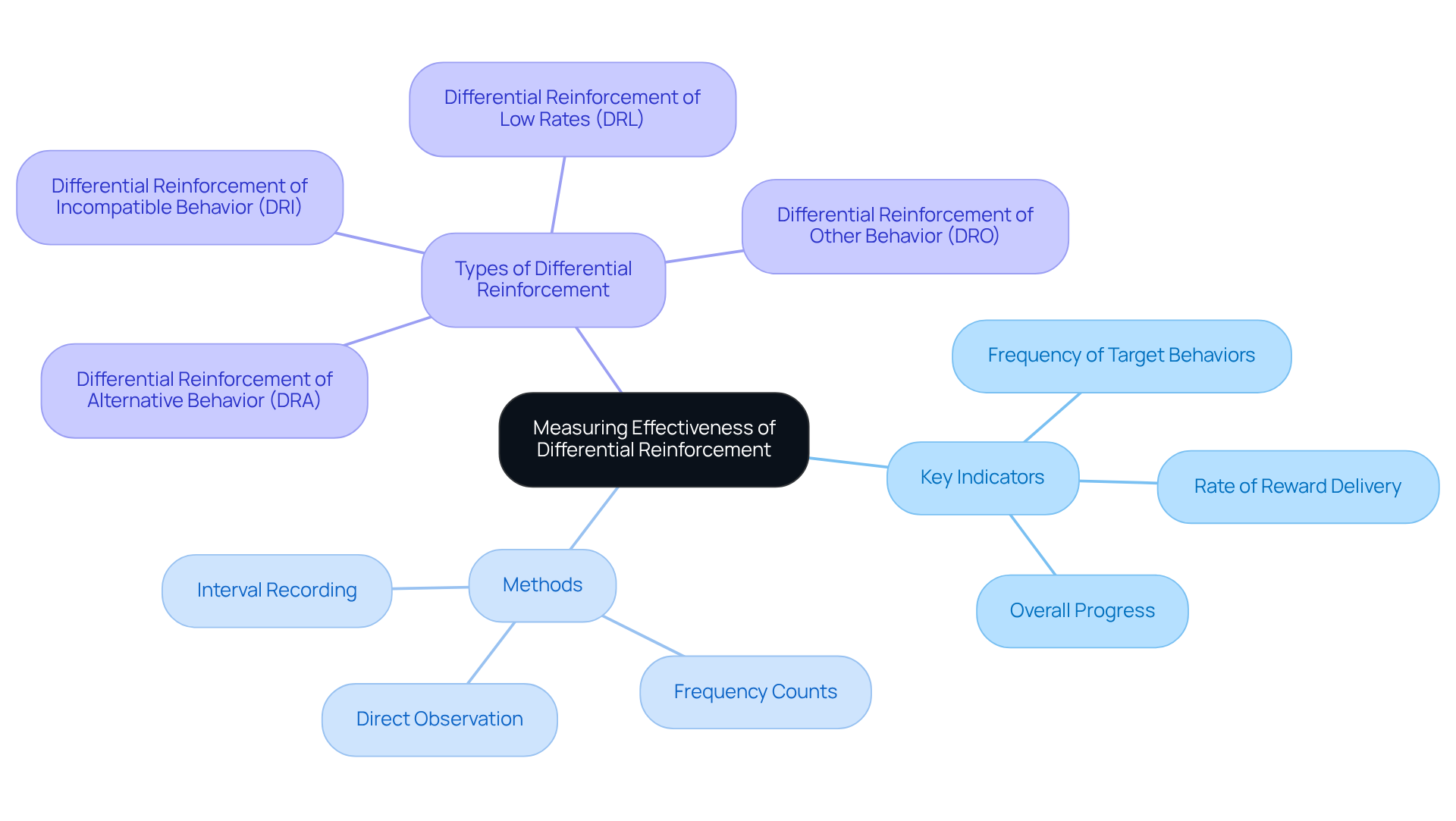
Frequent errors in implementing differential approaches often stem from inconsistent reward practices, ambiguous definitions of target actions, and a lack of consideration for personal preferences regarding incentives. Research underscores the critical role of consistent rewards in the efficacy of ABA interventions; studies reveal that immediate and reliable incentives significantly enhance the link between the desired action and its reward. BCBAs emphasize the necessity of clearly delineating the actions being targeted, as vague definitions can lead to confusion and ineffective interventions.
Furthermore, selecting incentives that resonate with the individual is paramount; customized motivational strategies have been demonstrated to elevate engagement and drive. For instance, the types of differential reinforcement ABA have proven effective in mitigating problematic behaviors across various settings. By addressing these pitfalls, practitioners can substantially enhance the effectiveness of their interventions, fostering more meaningful and enduring behavior changes.
To refine their practice, practitioners should consistently based on individual progress and preferences.
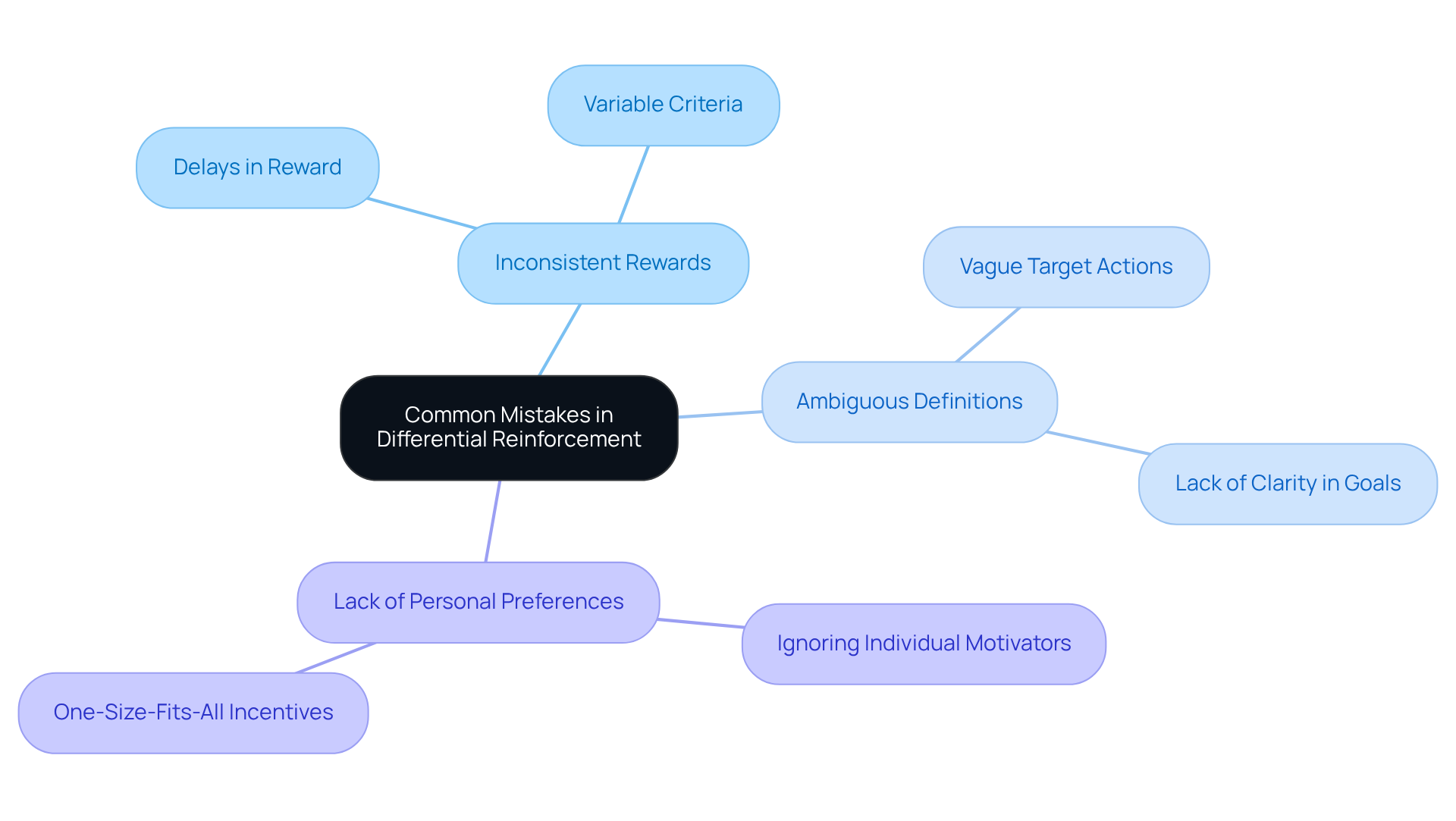
In the execution of differential support methods, Board Certified Behavior Analysts (BCBAs) must adhere to ethical principles that prioritize client welfare and dignity. This commitment necessitates:
Practitioners must remain vigilant regarding the potential for unintended consequences, striving to cultivate a supportive environment that fosters positive behavior change. A study by Karsten and Carr (2009) illustrates this point, revealing that the types of differential reinforcement in ABA, particularly when differentially reinforcing unprompted responses, can accelerate skill acquisition, thereby highlighting the critical role of effective reinforcement strategies.
By upholding these ethical standards, BCBAs not only enhance their practice's effectiveness but also ensure that their methods are respectful and responsible, aligning with the latest ethical guidelines established for 2025. As emphasized by Wong et al. (2015), evidence-based interventions play a vital role in maintaining ethical integrity in practice.
To further support ethical implementation, BCBAs should consider practical applications such as:
This ensures that interventions remain beneficial and aligned with client needs.
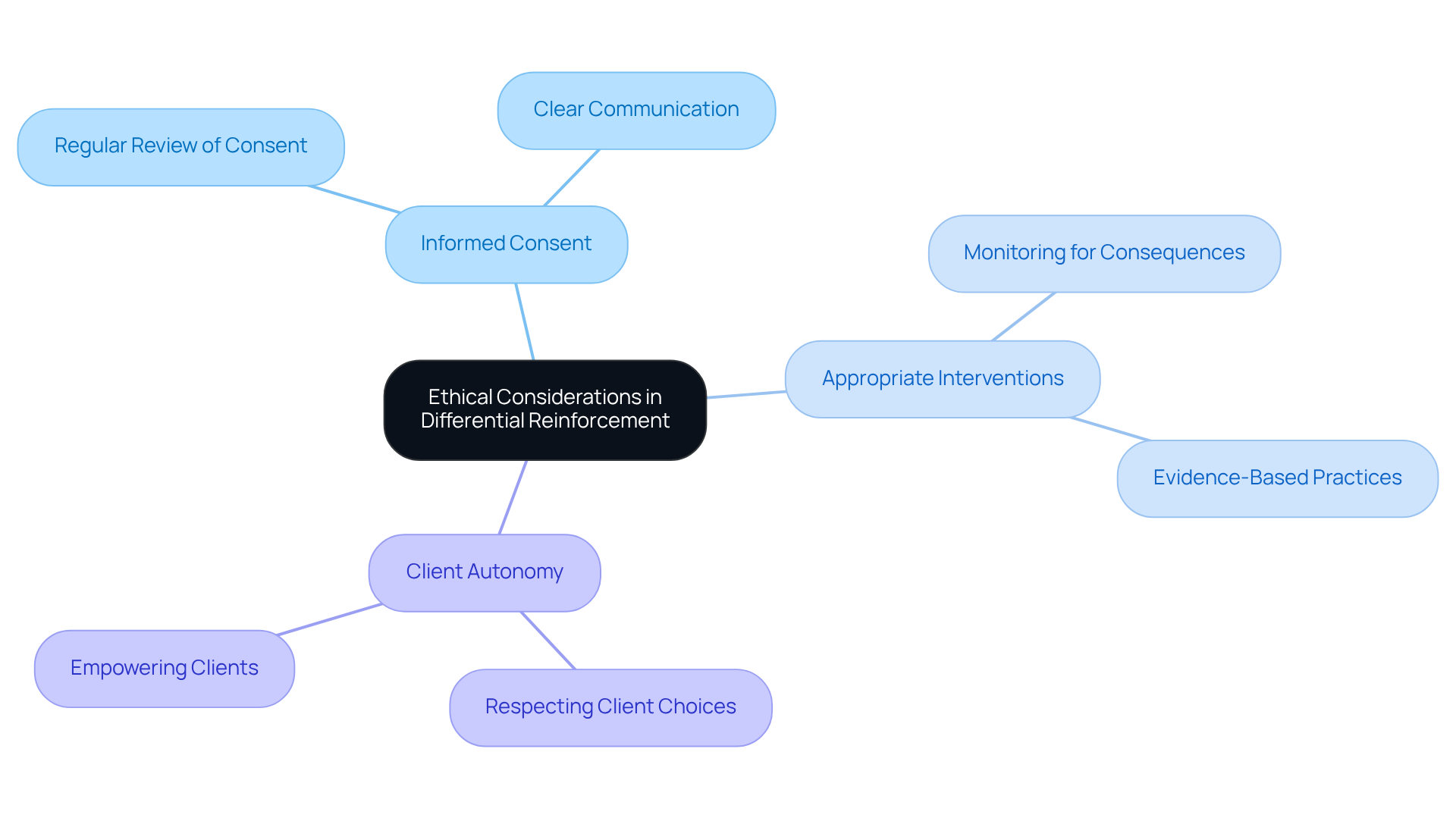
Differential reinforcement techniques in Applied Behavior Analysis (ABA) are essential strategies for promoting positive behavior changes while effectively reducing unwanted actions. Methods such as Differential Reinforcement of Alternative Behavior (DRA) and Differential Reinforcement of Incompatible Behavior (DRI) empower Board Certified Behavior Analysts (BCBAs) to tailor interventions to meet the unique needs of individuals, fostering a supportive environment conducive to growth and learning.
The significance of each type of differential reinforcement is paramount, particularly in educational settings. The following techniques play a crucial role:
The importance of data collection, customization, and ethical considerations in implementing these strategies underscores the necessity for a holistic approach in ABA practices.
In conclusion, the effective application of differential reinforcement strategies not only enhances behavioral outcomes but also aligns with ethical standards prioritizing client welfare. As the demand for BCBAs continues to grow, mastering these techniques becomes crucial for practitioners aiming to elevate their practice and achieve meaningful results. Embracing these methods can lead to significant improvements in both individual behavior and overall therapeutic success, making it imperative for professionals in the field to continually refine their understanding and implementation of differential reinforcement.
What is Hire ABA and its purpose?
Hire ABA is a specialized recruitment platform designed to streamline the job matching process for Board Certified Behavior Analysts (BCBAs) through personalized resume assessments and advanced job fit scoring, connecting qualified professionals with suitable job opportunities.
What is the projected job growth for BCBAs over the next decade?
The demand for Board Certified Behavior Analysts is projected to rise by 22% to 23% over the next decade.
How does Hire ABA support candidates in their job search?
Hire ABA creates a supportive environment for candidates, enhancing their chances of finding roles that align with their expertise and career aspirations by leveraging technology, including telehealth and remote work options.
What has been the trend in job vacancies for ABA specialists?
Job vacancies for specialists in the field have dramatically increased from 789 in 2010 to over 57,596 in 2022, reflecting the growing recognition of Applied Behavior Analysis as an effective treatment for autism and related disorders.
What is Differential Reinforcement of Alternative Behavior (DRA)?
DRA is a behavioral intervention strategy that reinforces a behavior that serves as a substitute for an unwanted behavior, promoting positive actions while reducing the occurrence of the undesired behavior.
How is DRA applied in educational settings?
DRA is used in educational environments to foster appropriate communication, leading to improved student engagement and reduced disruptive actions, such as praising students for raising their hands instead of calling out.
Why is it important to tailor DRA approaches?
Tailoring DRA approaches to the unique needs of each student is crucial for achieving success, as understanding the underlying motivations for behaviors helps create a supportive environment that encourages positive changes.
What is Differential Reinforcement of Incompatible Behavior (DRI)?
DRI is a technique that reinforces behaviors that cannot occur simultaneously with unwanted behaviors, such as rewarding a child for keeping their hands in their lap to reduce aggressive actions.
How effective is DRI in addressing challenging behaviors?
DRI has been shown to significantly reduce challenging behaviors, such as aggression, by promoting alternative responses that are incompatible with the undesired behavior.
What ethical considerations are associated with DRI?
Ethical considerations include ensuring that reinforcement strategies respect individual autonomy and avoid promoting detrimental actions while guiding children toward more adaptive responses.
Our expert recruitment strategies and AI-driven sourcing ensure that you receive top-notch candidates quickly, without compromising on quality. Whether you’re looking for BCBAs, Clinical Directors, or RBTs, we’ve got you covered.